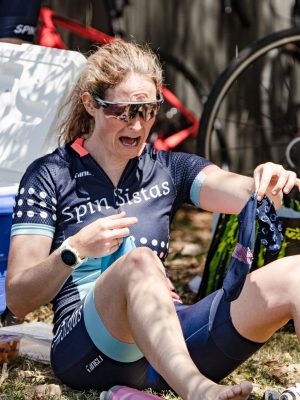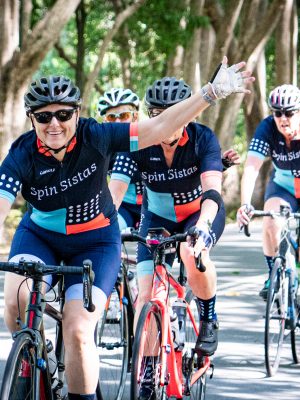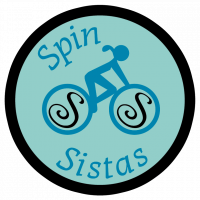Bunch etiquette
When riding in a group, there are some important guidelines to help keep everyone safe.
spin sistas
Bunch etiquette guidelines
The purpose of everyone maintaining good bunch etiquette when out riding on the road is to ensure that everyone stays safe. The following outlines the bunch etiquette rules for the Spin Sistas bunch rides.


- Abide by the relevant rules of the road at all times.
- In general, we ride two-abreast, except when using narrow roads or there are other hazards, such as parked cars and it is safer to ride in single file.
- To change the lead riders when riding two abreast, the instruction to “rotate” will be called by either of the lead riders and can be reinforced by waving a hand in a circular motion. The lead rider on the right moves forward and then over to the left to sit just in front of the lead rider on the left and the person at second wheel on the right moves forward two place to now be parallel with the new lead rider on the left. All other riders on the right move forward 2 spaces and the last rider on the left moves across to fill any gap on the right at the back.
- Do not ride more than two abreast, unless overtaking and when it is safe to do so.
- When transitioning from two abreast to single file, call “single” – can be reinforced by holding a flat hand vertically above the head (like a shark fin).
- When transitioning from two-abreast to single file, the rider on the right moves forward and slots in front of the rider on the left.
- When transitioning from single file to two-abreast call “double”.
- When transitioning from single file to two-abreast the reverse happens, every second rider moves out to the right and forward to draw up alongside the rider in front.
- No “half-wheeling”, ride in parallel pairs and avoid overlapping wheels with those in-front or behind.
- Keep to the left of the lane or use the cycle lane.
- Always overtake another rider on the right.
- Never “undertake” a rider or motor vehicle on the left.
- When drawing alongside another rider, call “on your right” or “on your left” so as not to surprise them.
- Always maintain a pace that is suitable for the whole group, not just those on the front.
- Always slow down for potential hazards (e.g. roundabouts, pedestrian crossings, corners, parked cars). Whilst your skills may be up to the task of taking a chicane line through a roundabout, others may not be so confident.
- Always accelerate slowly away from lights and after slowing for hazards, ensure that everyone is “on” before gradually resuming the desired pace.
- Avoid sudden changes of speed or direction unless absolutely necessary.
- If braking unexpectedly, call “slowing” or “stopping” as appropriate.
- Always keep pedalling when drinking or signalling.
- In general, if on the front, take things easier on the uphill section of rollers and put a little more effort on the downhill (others will benefit from the tow on the downhill and will be able to stay with you if you take it a bit easier going uphill). This minimises the concertina effect on rollers.
- Lead riders need to make decisions on changing lights for the whole group by calling clearly either “stopping” or “rolling”.
- Rear riders need to warn the bunch about approaching cars by calling “car back” and assess potential traffic hazards from behind whenever the bunch is manoeuvring on the road.
- Signal changes in direction by holding the arm out horizontally wither to the left or right and calling “turning left” or “turning right”.
- Signal changes of lane in the same way, but call “taking the lane”.
- When changing lanes the rear-most rider should check for traffic behind and clearly call either “car back” if there is traffic behind or “clear back” if it is safe to take the lane.
- Point out hazards on the road:
- Point out holes, sticks or rocks with an extended finger – can be reinforced by calling “hole”, “stick” or “rock”.
- Point out glass, gravel or other dispersed hazard by waving an outstretched hand at the ground – can be reinforced by calling “glass” or “gravel”.
- Point out hazards between pairs of riders by waving your central arm from side to side.
- Point out potential hazards such as parked cars, car doors, walkers or other riders on the left by pointing an extended finger across your back with your left arm – can be reinforced by calling “car”, “car door”, “walker up” or “rider up”.
- Call out potential hazards:
- “Clear” = junction ahead is clear of traffic (for clarity, avoid saying clear left or clear right).
- “Clear back” = no traffic to the rear of the group.
- “Car up” = car ahead of the group.
- “Car back” = car behind the group and about to overtake.
- “Car left/right” = car coming from junction on the left/right.
- “Car inside” = car “undertaking” on the left when not riding in the left most lane.
- “Rider(s) up” = cyclist(s) ahead, usually when group is about to overtake.
- “Rider(s) back” = cyclist(s) to rear of group about to overtake.
- “Walker up” = pedestrian ahead of the group about to be overtaken.
- “Stopping” = slowing to a stop.
- “Slowing” = unexpected use of brakes.
- “Rolling” = continuing through a junction or traffic lights
- “Wait” = don’t move over or take lane yet.
- “Over” = move across to take the indicated lane.
- “Single” = transition to single file – can be reinforced by holding a flat hand vertically above the head (like a shark fin).
- “Double” = transition to two abreast – can be reinforced by holding up two fingers in a “victory” sign.
- “On your left/right” = I am moving alongside on your left/right
- Hazards– usually reinforced by pointing or calling direction (“left”, “right” or “middle”),
- “Hole” = pothole or similar hazard.
- “Stick” = tree branch or similar hazard.
- “Rock” = boulder or rock.
- “Glass” = broken glass.
- “Gravel” = loose gravel.
- “Tram tracks” = group is crossing tram lines
- It is beholden upon riders on the front to be alert for potential hazards, provide clear indication of changes in direction at junctions and to adjust the pace of the group according to the road conditions. This includes slowing at junctions, calling “stopping” or “rolling” at lights, calling “taking the lane” and indicating right when intending to turn right and accelerating gradually after clearing junctions and other hazards. It is also important for those on the front to ensure that all are “on” before resuming a faster pace.
- It is beholden upon riders at the rear to be alert for potential hazard from behind and to ensure that the group is safe to manoeuvre.
- In larger groups it is important to pass messages forwards and backwards in the group whether this be verbal or signalled. You cannot assume that because you have heard a call or seen a signal that those in front or behind will have. So remember to ‘pass it on’. This may mean pointing out hazards even before you have seen what the hazard is youself.
Keep an eye out for your sista.
If any of the terms are not clear or you would like to ask some questions, get in touch with us via our Facebook group.
